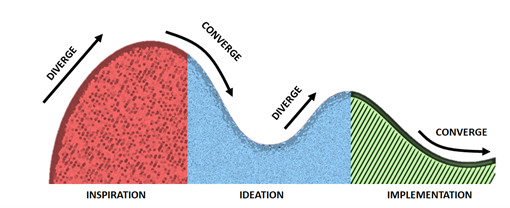Written by: Michael Parent
Lean Six Sigma (LSS) is entering a new era. The nature of work is changing and has already changed. Workers are remote. Processes no longer just produce physical widgets, but now produce information. Resiliency and adaptability have taken precedence over simple efficiency. Amidst these dynamics, the strategic focus of C-suite executives is changing as well; innovation and novelty dominate the executive conversations the world over. And the quality community has all but remained silent in these conversations.
To stay relevant amid these macro developments, Lean Six Sigma must adapt and expand its paradigms and tools to continue its dominance as the preferred improvement and problem-solving technology. One way that Lean Six Sigma can accomplish all of this is by incorporating principles of Human-Centered Design (HCD) into the existing Lean framework.
What is Human Centered Design?
Like Lean, Human-Centered Design is a problem-solving framework. While the purpose of Lean is to build operational excellence through the removal of waste and the streamlining of value-added processes, Human Centered Design is aimed at leveraging interpersonal experiences to better understand the needs and wants of the end-user and then design a product that fits that need. Human-Centered Design has been around for about 20 years and is gaining wide popularity, particularly in Silicon Valley and amongst the “UX” community. As Figure 1 demonstrates, Human-Centered Design, like Lean and Six Sigma, has its own methodology that practitioners work through as they seek inspiration from their customers, prototype their ideas, and finally converge into a workable solution for the user group. In this article, my aim is not to give a full treatment of HCD, but merely to show how the first phase of HCD, inspiration, can improve and inform Lean efforts.
HCD Informs the Gemba
When Lean belts talk about waste walks, or going to the Gemba, the resulting activity is usually to go out to a production floor, observe an operation, talk with an operator, and glean insights from these experiences. To be sure, this is a good practice, and no Lean effort is complete without them. But is there a way to glean more insights, identify more knowledgeable users or personnel that we could talk to an even greater understanding of the current state opportunities? Human-Centered Design would suggest there is. Through the lens of HCD, we can experience the Gemba walk in more informed and thoughtful ways. We can categorize each unique interaction or experience into different user groups. Their unique perspective, when taken together, creates a fuller and more holistic picture for us to consider in our Lean current state analysis. Consider the following categories:
Experts: Experts provide a unique perspective that only they can provide. A perspective of an informed and knowledgeable outsider looking in. Usually when people think of experts, they think of scholars and academics. But the expert group is far more diverse than professors and researchers. An expert is anybody who has an intellectual expertise about a particular organization, operation, industry, or subject matter. Parents and grandparents can be experts about aspects of bringing up children. Religious clergy may possess expertise in volunteerism and community involvement. Community leaders, consultants, and educators can all contribute expertise in different settings.
Often this user group is overlooked in Lean Gemba walks. After all, they aren’t where the work is being done. But nevertheless, their distance can serve as a strength. Experts can provide invaluable insights into macro changes in their relevant field. Experts may also possess a better understanding of history. Stories of “How we got here” may be revealing and telling, especially if the constraints that built our current state no longer exist or can easily be overcome with newer technologies.
Mainstream Users: Mainstream users are typically who you encounter on a traditional Gemba walk. They embody the average worker on machine or nurse on a hospital ward. Typically, these individuals aren’t using the full capabilities of their environment. They are familiar enough to know how to do their job efficiently or use the requisite technology correctly, but they are not much more engaged than this. Not every person can be a super user. Consequently, designers using the Human-Centered Design framework care about this user group because this is the user group who will most broadly be affected by the change.
The iPhone presents an interesting example of the importance of mainstream users. Before the iPhone, people owned digital cameras. And while each digital camera might have had settings to adjust shutter speed, aperture and focus, most users didn’t use these settings and instead kept the camera on “automatic”. The iPhone developers recognized this user behavior. They didn’t need to create an elegant and sophisticated camera; the vast majority of users would find all the utility they needed with a basic camera with basic automatic settings.
Extreme Users: Unlike mainstream users, extreme users are users who spend an extended period of time with a product or service and have used all the product features and capabilities. Because these extreme users are using the product at its absolute limit, they provide valuable insights about the direction innovation should take the product and what future demand will look like. These are insights the mainstream target audience simply does not possess. For a Lean Six Sigma project, extreme users offer an amazing opportunity. They very well might already have ideas about how to improve a procedure before you even start investigating.
The opportunity for manufacturers to learn from these extreme users is highly valuable and irreplaceable. This is why we see manufacturers – like particularly high-performance sports brands – sponsor athletes and teams. They’re not just looking for brand recognition from the general public but rather want exclusive access to the insights of extreme users, which will generate new opportunities for existing product adaptations and new product lines. [1]
Conclusion
Lean Six Sigma remains a consistent force within the industry. But amidst the changes to the work environment, nature of work, the areas in which LSS is employed, and the strategic directions of companies, it’s fair to say that an update to the tools should be welcomed by the LSS and quality community. The HCD framework is one avenue towards this goal with a myriad of benefits. The different user categories serve as just one example. Different user categories inform us that not all user groups are the same and that unique and specific insights can be gathered from each user group, which cannot be obtained from the others. Distinctions are often lost in traditional Lean Gemba walks. Human-Centered Design allows us to identify and appreciate differences and distinctions while still respecting, supporting and augmenting the Respect for People ethos that has abided within Lean for over 60 years.
[1] Copyrighted material excerpted from the book, The Lean Innovation Cycle: A Multi-Disciplinary Framework for Designing Value with Lean and Human-Centered Design by Michael Parent (Routledge, 2022)
About the Author:
Michael Parent is a Lean Six Sigma Master Black Belt and Management Consultant. He earned a Bachelor in Science from the University of Michigan in Ann Arbor and an MBA from William and Mary. He is the author of The Lean Innovation Cycle: A Multi-Disciplinary Framework for Designing Value with Lean and Human-Centered Design (Routledge, 2022).





